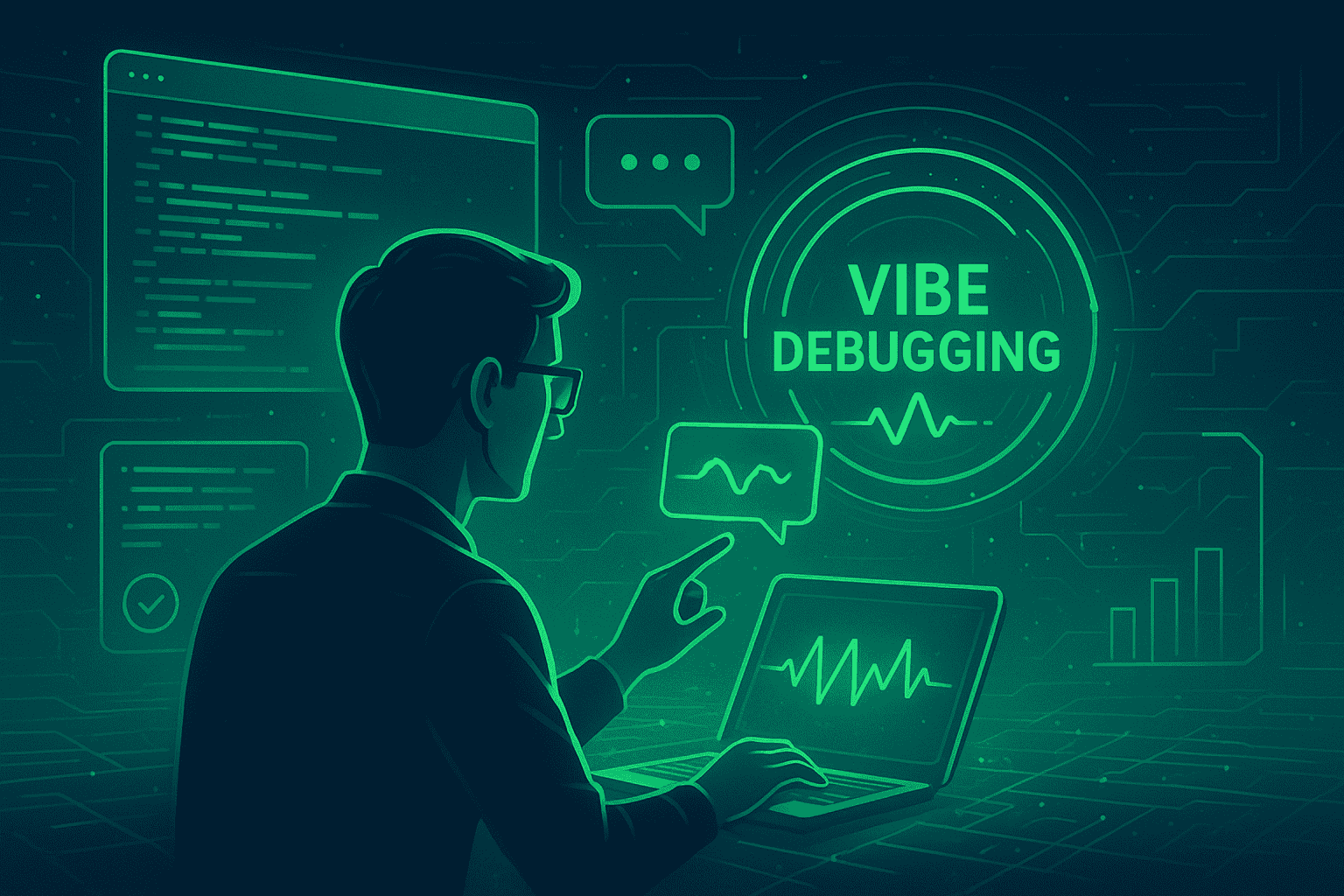Software teams today juggle velocity, reliability, and security under relentless complexity. Microservices, ephemeral environments, and CI/CD have made reproducing issues locally nearly impossible. This constant context switching drains focus and burns engineers out. This is where Vibe debugging comes in.
Vibe debugging is emerging as the antidote—a conversational, AI-driven approach that brings context back into flow. It helps engineers diagnose issues faster, collaborate better, and keep their systems healthy without drowning in dashboards or logs.
It’s not about replacing humans—it’s about giving developers and leaders the mental space to engineer with clarity and confidence.
Understanding The Vibe In Vibe Debugging
What is vibe debugging
Vibe debugging transforms the debugging process into a dialogue. Instead of manually trawling through logs, QA metrics, and traces, engineers ask questions like, “Why did latency spike after the last deployment?” The system—powered by intelligent agents—connects observability data, code changes, and runtime signals to give an evidence-backed narrative.
It’s debugging powered by understanding, not just output.
What “vibe” really means
Every system has a unique behavioral fingerprint—its vibe. When performance metrics, error rates, and usage patterns deviate from the usual rhythm, the system’s “vibe” feels off. Vibe debugging for engineering continuously learn these baselines and detect early behavioral drifts before they snowball into outages.
It’s the equivalent of a mechanic who knows when an engine “sounds” wrong before it breaks.
How it differs from traditional debugging
Traditional debugging is reactive and linear—you find an error, reproduce it, trace the code, and fix it. Vibe debugging is proactive and holistic—it captures live system context, correlates behavioral changes, and lets engineers reason about incidents conversationally.
Where traditional debugging gives you a microscope, vibe debugging hands you a map.
Why Teams Should Care About Vibe Debugging
Preserve developer flow
Context switching kills creativity. Jumping between terminals, dashboards, and Jira tickets interrupts deep work. Vibe debugging keeps engineers in flow by delivering insights directly through natural language queries. The system does the searching, correlating, and summarizing—so the developer stays focused.
The result is less thrash and more high-impact engineering time.
Reduce time to actionable insight
Debugging speed isn’t just about how fast you fix a bug—it’s about how quickly you understand it. Vibe debugging agents parallelize log searches, version diffs, and telemetry analysis, surfacing the most probable cause first.
This drastically reduces mean time to detect (MTTD) and mean time to resolve (MTTR), helping teams stabilize systems faster and minimize customer impact.
Make onboarding easier
Every team has that one person who “just knows” how the system behaves. Vibe debugging democratizes that intuition. By logging each conversational investigation and linking it to evidence, vibe systems create a rich knowledge base that helps new hires ramp up faster and veterans offload expertise efficiently.
Strengthen security posture
A vibe debugging system that continuously monitors system baselines can detect behavioral anomalies that static scans miss—like sudden latency in authentication endpoints or abnormal data flows. This behavioral awareness complements traditional code security reviews, creating a safety net across runtime and code.
Metrics That Matter For Vibe Debugging
Mean time to diagnose (MTTD) and mean time to resolve (MTTR)
These two metrics remain the gold standard for measuring incident efficiency. Vibe debugging helps lower both by correlating evidence faster and cutting redundant tool-hopping. Some early adopters report reductions in MTTR by over 40%.
Bug and vulnerability density post-deployment
A mature vibe debugging development workflow identifies regressions earlier, catching behavioral anomalies before they hit production. This reduces post-deployment bug density and strengthens release confidence.
Context-switch events per incident
Every extra tool or tab visited during an investigation increases cognitive load. With conversational reviews and debugging, engineers can stay in one interface for most of the diagnosis—reducing tab-hopping, Slack pings, and dashboard detours.
Developer satisfaction and trust
The success of any AI-driven system depends on trust. Tracking satisfaction through surveys and false-positive rates helps ensure engineers feel supported—not replaced—by the system. High-trust adoption directly correlates with faster incident resolution and lower burnout.
Best Practices And Tips For Vibe Debugging
Start with high-signal data
Don’t overload your system with every possible metric. Focus on meaningful signals—deploy events, error spikes, traffic anomalies. Smaller, richer datasets lead to faster, more accurate insight.
Annotate critical paths
Add lightweight annotations to key workflows—checkout, login, payments—so the agent can easily correlate user actions to code paths. Context-aware data makes for smarter, more explainable answers.
Collaborate through conversational sessions
Use the agent’s chat history as a living incident record. It becomes a searchable thread where engineers, SREs, and PMs can see what was asked, what was found, and what was fixed. Over time, this thread evolves into your institutional debugging memory.
Keep traditional debugging habits alive
Even with AI in the loop, don’t abandon fundamentals like breakpoints, unit tests, and reproducible environments. Vibe debugging identifies where to look; traditional debugging still determines why it broke and how to fix it with confidence.
Escalate automation carefully
Begin with advisory suggestions—recommendations on probable causes or safe rollbacks. Once precision stabilizes, allow limited auto-remediation for low-risk incidents. Human oversight should remain for security-sensitive or high-impact changes.
Protect your data
Vibe debugging requires broad context visibility. Implement strict access control, data masking, and retention policies. Guardrails aren’t optional—they’re what make AI debugging enterprise-safe.
Integrate with CI/CD
Feed vibe debugging insights back into your CI/CD pipeline. Flag anomalies pre-deploy, validate them post-deploy, and continuously retrain your models with production feedback.
Advantages And Disadvantages: Vibe Debugging Vs Regular Debugging
| Dimension | Vibe Debugging (AI-driven) | Regular Debugging (Manual) |
|---|---|---|
| Scope | Cross-tool, combines code, logs, and telemetry | Localized to one environment or codebase |
| Speed to Insight | Rapid parallel correlation | Slower, sequential exploration |
| Explainability | Summarized natural-language insights | Full visibility through manual tracing |
| Reproducibility | Depends on data capture fidelity | Fully deterministic if reproduced locally |
| Automation Risk | Needs human guardrails | Low, human-controlled |
| Operational Cost | Higher compute and data storage; less human time | Lower system cost; more human effort |
| Knowledge Transfer | Creates searchable, contextual documentation | Requires manual sharing or wikis |
| Security Exposure | Must mask sensitive data across systems | Limited to local development environments |
Vibe debugging offers speed, clarity, and collaboration; traditional debugging offers precision, control, and reliability. The future belongs to teams that blend both seamlessly.
Enterprise Challenges With Vibe Debugging
While AI code review tools are transforming code quality and dev velocity, its adoption within enterprise environments presents unique challenges. These hurdles stem from the inherent complexity of large-scale systems, organizational structures, and the evolving nature of development practices.
1. Integration with Legacy Systems
Many enterprises operate on legacy systems that were not designed with modern debugging practices in mind. Integrating vibe debugging tools into these environments can be complex, requiring significant modifications to existing infrastructure and workflows. The lack of standardized interfaces and outdated technologies can hinder seamless integration.
2. Data Privacy and Security Concerns
Enterprises handle sensitive data, and the implementation of vibe debugging tools often necessitates access to extensive system logs and user interactions. This raises concerns about data privacy and security, especially when dealing with personally identifiable information (PII) or proprietary business data. Ensuring compliance with regulations such as GDPR and maintaining robust security protocols is paramount.
3. Resistance to Change
Organizational inertia can impede the adoption of new technologies. Development teams accustomed to traditional debugging methods may be resistant to adopting AI-driven approaches. Overcoming this resistance requires effective change management strategies, including training, clear communication of benefits, and gradual implementation to build trust in the new system.
4. Scalability and Performance
As enterprises scale their operations, the volume of data generated increases exponentially. Vibe debugging tools must be capable of processing and analyzing large datasets in real-time without compromising system performance. Ensuring that these tools can handle the scale of enterprise environments is crucial for their effectiveness.
5. Cost of Implementation
The initial investment required to implement vibe debugging tools can be substantial. Pricing include purchasing or developing the necessary software, integrating it into existing systems, and training staff. For many enterprises, especially those with limited budgets, justifying this investment requires clear demonstrations of the return on investment (ROI), such as reduced downtime and improved developer productivity.
Why Traditional Debugging Still Matters
AI is great at spotting patterns—but not at understanding intent. Some bugs demand a deep, deterministic dive that only human reasoning provides. Race conditions, complex state corruption, and edge-case performance issues still need classic debugging methods.
Traditional debugging also keeps engineers sharp. Stepping through code teaches mental models that no AI assistant can replicate. This foundational understanding ensures that when automation falters, humans remain capable of steering the system back to safety.
How Panto AI Is Building End-To-End Vibe Debugging
While many companies are exploring AI-assisted debugging, Panto AI is pioneering a truly end-to-end vibe debugging system. Their approach connects three layers: AI code review, behavioral monitoring, and conversational debugging.
Panto AI reimagines debugging as an ongoing dialogue between developers and AI agents—working together to spot, interpret, and resolve issues without disrupting momentum. By fusing intelligent automation with human insight, it marks a real step toward debugging that thinks with developers, not just for them.
What sets Panto apart is its focus on security and explainability. Every insight is traceable to its evidence. This end-to-end coverage turns debugging from a reactive firefight into a continuous, insight-driven discipline.
Practical Adoption Checklist For Engineering Leaders
- Identify your pain points. Start where incidents hurt most—customer-facing APIs, high-load services, or complex microservice chains.
- Instrument wisely. Capture data from key workflows first, then expand gradually.
- Adopt advisory mode. Let the agent suggest fixes before automating actions.
- Measure outcomes. Track MTTD, MTTR, defect density, and developer satisfaction before and after implementation.
- Set strong governance. Define access controls, retention periods, and masking policies from day one.
- Close the loop. Feed insights from incidents back into your models, code reviews, and playbooks.
Adoption isn’t just a tooling change—it’s a cultural shift toward evidence-driven engineering.
Conclusion
Vibe debugging for engineering represents the next evolution of software craftsmanship, where AI and engineers work in sync to maintain complex systems with less friction and more intuition.
Still, the smartest path forward is a hybrid one: let AI handle the tedious correlation while humans bring creativity, ethics, and deep reasoning to the table. The synergy between vibe debugging and traditional debugging defines the foundation of effortless engineering.
Engineering leaders who embrace this model will not only ship faster—they’ll build teams that are calmer, more curious, and more capable of scaling innovation safely.






